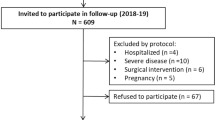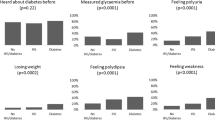Abstract
Objective:
The prevalence of diabetes mellitus is known to be increasing rapidly worldwide, but few population-based surveys have been undertaken in Africa or the Middle East. The aims of this study are to report the prevalence of diabetes mellitus and impaired fasting glucose (IFG) in Tunisia, to compare the prevalence to previous studies and to analyse the relationship between diabetes and age, sex, area of residency and body mass index (BMI).
Subjects and setting:
We have used data from the Tunisian National Nutrition Survey, a cross-sectional health study providing a large nationally representative sample of the Tunisian population including 3729 adults. We used the American Diabetes Association diagnostic criteria to determine the prevalence of diabetes mellitus and IFG.
Results:
The overall diabetes prevalence was 9.9% (9.5% in men and 10.1 in women) giving age-adjusted prevalence of diabetes of 8.5% (7.3% in men and 9.6% in women). Step-wise logistic regression showed age of more than 40 years, urban residency and high BMI to each be significantly and independently related to diabetes prevalence. The prevalence of diabetes mellitus has more than doubled in Tunisia over a 15-year period.
Conclusions:
Our study has demonstrated a high prevalence of diabetes in the adult population with a wide difference among the rural and urban areas with an increased prevalence compared to previous studies. The results underline the need to increase public awareness and to emphasize the benefit of lifestyle modification in order to prevent type II diabetes.
This is a preview of subscription content, access via your institution
Access options
Subscribe to this journal
Receive 12 print issues and online access
$259.00 per year
only $21.58 per issue
Buy this article
- Purchase on Springer Link
- Instant access to full article PDF
Prices may be subject to local taxes which are calculated during checkout
Similar content being viewed by others
References
Abdul-Rahim HF, Husseini A, Bjertness E, Giacaman R, Gordon NH, Jervell J (2001). The metabolic syndrome in the west bank population. An urban–rural comparison. Diabetes Care 24, 275–279.
Ajlouni K, Jaddou H, Batieha A (1998). Diabetes and impaired glucose tolerance in Jordan: prevalence and associated risk factors. J Intern Med 244, 317–323.
Al-Habori M, Al-Mamari M, Al Meeri A (2004). Type II diabetes mellitus and impaired glucose tolerance in Yemen: prevalence, associated metabolic changes and risk factors. Diabetes Res Clin Pract 65, 275–281.
Al-Mahroos F, McKeigue PM (1998). High prevalence of diabetes in Bahrainis: association with ethnicity and raised plasma cholesterol. Diabetes Care 21, 936–942.
Asfour MG, Lambourne A, Soliman A, Al-Behlani S, Al-Asfoor D, Bold A et al. (1995). High prevalence of diabetes mellitus and impaired glucose tolerance in the Sultanate of Oman: results of the 1991 National Survey. Diabetes Med 12, 1122–1125.
Bouguerra R, Ben Salem L, Alberti H, Ben Rayana C, El Khadhi A, El Alti J et al. (2006). The prevalence of metabolic abnormalities in the Tunisian adult: a population based study. Diabetes Metab 32, 215–221.
Dunstan DW, Zimmet PZ, Welborn TA, De Courten MP, Cameron AJ, Sicree RA et al. (2002). The rising prevalence of diabetes and impaired glucose tolerance. The Australian Diabetes, Obesity and Lifestyle Study. Diabetes Care 25, 829–834.
Elbagir MN, Eltom MA, Elmahadi EM, Kadam MS, Berne C (1996). A population-based study of the prevalence of diabetes and impaired glucose tolerance in adults in northern Sudan. Diabetes Care 19, 1126–1128.
Elbagir MN, Eltom MA, Elmahadi EA, Kadam MS, Berne C (1998). A high prevalence of diabetes mellitus and impaired glucose tolerance in the Danagla Community in Northern Sudan. Diabetes Med 15, 164–169.
Ghannem H, Maarouf R, Tabka A, Haj frej A, Marzouki M (1993). La triade obésité, hypertension et troubles de la glycorégulation dans une population semi-urbaine du Sahel Tunisien. Diabetes Metab 19, 310–314.
Gharbi M, Akrout M, Zouari B (2002). Diabetes non insulino-dependent; prevalence et facteurs de risque en Tunisie. Rev Epidemiol Sante Publique 50, 349–355.
Harris MI, Flegal KM, Cowie CC, Eberhardt MS, Goldstein DE, Little RR et al. (1998). Prevalence of diabetes, impaired fasting glucose, and impaired glucose tolerance in US adults. The third national health and nutrition examination survey, 1988–1994. Diabetes Care 21, 518–524.
Hayashi T, Boyko EJ, Leonetti DL, McNeely MJ, Newell-Morris L, Kahn SE et al. (2003). Visceral adiposity and the risk of impaired glucose tolerance. Diabetes Care 26, 650–655.
Jaber LA, Brown MB, Hammad A, Nowack SN, Zhu Q, Ghafoor A et al. (2003). Epidemiology of diabetes among Arab Americans. Diabetes Care 26, 308–313.
King H, Aubert RE, Herman WH (1998). Global burden of diabetes, 1995–2025: prevalence, numerical estimates, and projections. Diabetes Care 21, 1414–1431.
Mokdad AH, Ford ES, Bowman BA, Nelson DE, Engelgau MM, Vinicor F et al. (2000). Diabetes trends in the US: 1990–1998. Diabetes Care 23, 1278–1283.
Mokdad AH, Bowman BA, Ford ES, Dietz WA, Vinicor F, Bales VS et al. (2003). Prevalence of obesity, diabetes, and obesity-related health risk factors, 2001. JAMA 289, 76–79.
Papoz L, Ben khalifa F, Eschwege E, Ben Ayed H (1988). Diabetes mellitus in Tunisia: description in urban and rural populations. Int J Epidemiol 17, 419–422.
Ramachandran A, Snehalatha C, Latha E, Vijay V, Viswanathan M (1997). Rising prevalence of NIDDM in an urban population in India. Diabetologia 40, 232–237.
Ramachandran A, Snehalatha C, Latha E, Manoharan M, Vijay V (1999). Impacts of urbanisation on the lifestyle and on the prevalence of diabetes in native Asian Indian population. Diabetes Res Clin Pract 44, 207–213.
Samer J (2003). Health and development in the Arab world: which way forward? BMJ 326, 141–143.
Satman I, Yilmaz T, Sengül A, Salman S, Salman F, Uygur S et al. (2002). Population-based study of diabetes and risk characteristics in Turkey. Results of the Turkish Diabetes Epidemiology Study (TURDEP). Diabetes Care 25, 1551–1556.
The Expert Committee on the Diagnosis and Classification of Diabetes Mellitus (1980). Expert on Diabetes Mellitus, Second Technical Report Series No.646 World Health Organisation: Geneva.
The Expert Committee on the Diagnosis and Classification of Diabetes Mellitus (1997). Report of the expert committee on the diagnosis and classification of diabetes mellitus. Diabetes Care 20, 1183–1197.
United Nations Population Division. World Population Prospects Population database. http://esa.un.org/unpp.
Wild S, Roglic G, Green A, Sicree R, King H (2004). Global prevalence of diabetes estimates of the year 2000 and projections for 2030. Diabetes Care 27, 1047–1053.
World Health Organisation (1997). Global Prevalence and secular trends in obesity. Obesity. Preventing and managing the global epidemic. Report of a WHO Consultation on Obesity. World Health Organisation: Geneva, pp 17–40.
Zimmet P (2003). The burden of type 2 diabetes: are we doing enough? Diabetes Metab 29, 6S9–6S18.
Acknowledgements
The Tunisian National Nutrition Study was funded by the National Institute of Nutrition and we thank all the participants and health professionals involved in the study.
Author information
Authors and Affiliations
Corresponding authors
Rights and permissions
About this article
Cite this article
Bouguerra, R., Alberti, H., Salem, L. et al. The global diabetes pandemic: the Tunisian experience. Eur J Clin Nutr 61, 160–165 (2007). https://doi.org/10.1038/sj.ejcn.1602478
Received:
Revised:
Accepted:
Published:
Issue Date:
DOI: https://doi.org/10.1038/sj.ejcn.1602478
Keywords
This article is cited by
-
Prevalence of diabetic retinopathy in patients with diabetes in Alexandria and North-West Delta, Egypt
International Ophthalmology (2023)
-
High prevalence of diabetes in elderly of Iran: an urgent public health issue
Journal of Diabetes & Metabolic Disorders (2022)
-
Cardio-metabolic risk factors in Tunisia: state of the art
Internal and Emergency Medicine (2020)
-
A systematic analysis on prevalence and sub-regional distribution of undiagnosed diabetes mellitus among adults in African countries
Journal of Diabetes & Metabolic Disorders (2020)
-
A prospective multi-country observational trial to compare the incidences of diabetic ketoacidosis in the month of Ramadan, the preceding month, and the following month (DKAR international)
Journal of Diabetes & Metabolic Disorders (2016)



